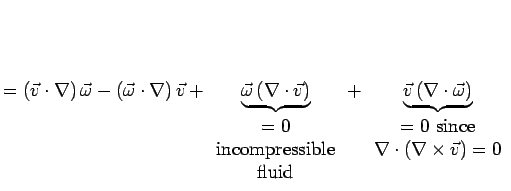
13.021 - Marine Hydrodynamics, Fall 2003
Lecture 9
Copyright © 2003 MIT - Department of Ocean
Engineering,
All rights reserved.
Return to viscous incompressible flow.
N-S equation:

Then,

since
![]() for any
for any ![]() (conservative forces)
(conservative forces)
Now consider the vector identities:
 |
||
 where where |
||
 |
||
 |
Therefore,
| or | ||
 |
If
![]() then
then
![]() , so if
, so if
![]() everywhere at one time,
everywhere at one time,
![]() always.
always.

Also since ![]() 1 or 2 mm
1 or 2 mm![]() /s, in 1 second,
diffusion distance
/s, in 1 second,
diffusion distance
![]() , whereas diffusion time
, whereas diffusion time
![]() . So for a diffusion
distance of L = 1cm, the necessary diffusion time needed is
O(10)sec.
. So for a diffusion
distance of L = 1cm, the necessary diffusion time needed is
O(10)sec.
Then,

so in 2D we have
 |
If ![]() = 0,
= 0,
![]() , i.e. in 2D, following a particle, the angular velocity is conserved. Reason: in 2D, the length of a vortex tube cannot change due to continuity.
, i.e. in 2D, following a particle, the angular velocity is conserved. Reason: in 2D, the length of a vortex tube cannot change due to continuity.
 |
For example:



What really happens as the length of the vortex tube
L increases?
IFCF (Ideal fluid under the influence of conservative forces) is no longer a valid assumption.
Why?
Ideal flow assumption implies that the inertia forces are much larger than the viscous effects (Reynolds number).
 Length increases
Length increases Therefore IFCF is no longer valid.
If
![]() at some time
at some time ![]() , then
, then
![]() always for ideal flow under conservative body
forces by Kelvin's theorem. Given a vector field
always for ideal flow under conservative body
forces by Kelvin's theorem. Given a vector field
![]() for which
for which
![]() , then there exists a potential function (scalar) - the velocity potential - denoted as
, then there exists a potential function (scalar) - the velocity potential - denoted as ![]() , for which
, for which
Note that
![]() for any
for any ![]() , so irrotational flow guaranteed automatically. At a point
, so irrotational flow guaranteed automatically. At a point ![]() and time
and time ![]() , the velocity vector
, the velocity vector
![]() in cartesian coordinates in terms of the potential function
in cartesian coordinates in terms of the potential function
![]() is given by
is given by


The velocity vector ![]() is the gradient of the
potential function
is the gradient of the
potential function ![]() , so it always points towards higher
values of the potential function.
, so it always points towards higher
values of the potential function.
Governing Equations:
Continuity:
Number of unknowns
![]()
Number of equations
![]()
Therefore the problem is closed. ![]() and
and ![]() (pressure) are decoupled.
(pressure) are decoupled. ![]() can be solved independently
first, and after it is obtained, the pressure
can be solved independently
first, and after it is obtained, the pressure ![]() is evaluated.
is evaluated.
Euler eq:
 |
Substitute
![]() into the Euler's equation above, which gives:
into the Euler's equation above, which gives:
 |
or
 |
which implies that
 |
![$\displaystyle p = - \rho \left[ {\frac{\partial \phi }{\partial t} + \frac{1}{2}\left\vert
{\nabla \phi } \right\vert^2 + gy} \right] + F(t)$](img63.gif) |
Summary: Bernoulli equation for ideal flow.
 |
 |
 Venturi pressure (created by
velocity) Venturi pressure (created by
velocity) |
 |

 |

Note: On a free-surface
![]() .
.
Then
 for any
for any
![]() i.e. satisfies continuity automatically.
i.e. satisfies continuity automatically.
Required for irrotationality:
For 2D flow:
![]() and
and
![]() .
.

Set
![]() and
and
![]() ,
then
,
then
![]()
So, for 2D:
 |
Then, from the irrotationality (see (1))
![]() and
and ![]() satisfies
Laplace's equation.
satisfies
Laplace's equation.


Again let
![]() and
and
![]() , then
, then
![]() and
and
![]() .
.
In 2D:
![]() and
and
![]() .
.
We define
 |

For ![]() to be single-valued,
to be single-valued, ![]() must be path independent.
must be path independent.
 or
or 
Therefore, ![]() is unique because of continuity.
is unique because of continuity.
Let
![]() be two points on a given streamline
(
be two points on a given streamline
(
![]() on streamline)
on streamline)

 |
Therefore,
![]() ,i.e.,
,i.e., ![]() is a
constant along any streamline. For example, on an impervious
stationary body
is a
constant along any streamline. For example, on an impervious
stationary body
![]() , so
, so ![]() = constant on the body is the
appropriate boundary condition. If the body is moving
= constant on the body is the
appropriate boundary condition. If the body is moving
![]()
 on
the boddy on
the boddy |

Flux
![]() .
Therefore,
.
Therefore,
![]() and
and
![]()

Summary: Potential formulation vs. Stream-function formulation for ideal flows
table
| potential | stream-function | |
| definition |
|
|
| continuity
|
|
automatically satisfied |
| irrotationality
|
automatically satisfied |
 |
| in 2D
|
|
|
| Cartesian (x, y) |

|
Cauchy-Riemann equations for ( (real, imaginary) part of an analytic complex function of z = x +iy |
| Polar (r, |
 |
| For irrotational flow | use | |
| For incompressible flow | use | |
| For both flows | use |
Given ![]() or
or ![]() for 2D flow, use Cauchy-Riemann
equations to find the other:
for 2D flow, use Cauchy-Riemann
equations to find the other:
For example: ![]() = xy
= xy ![]() = ?
= ?
